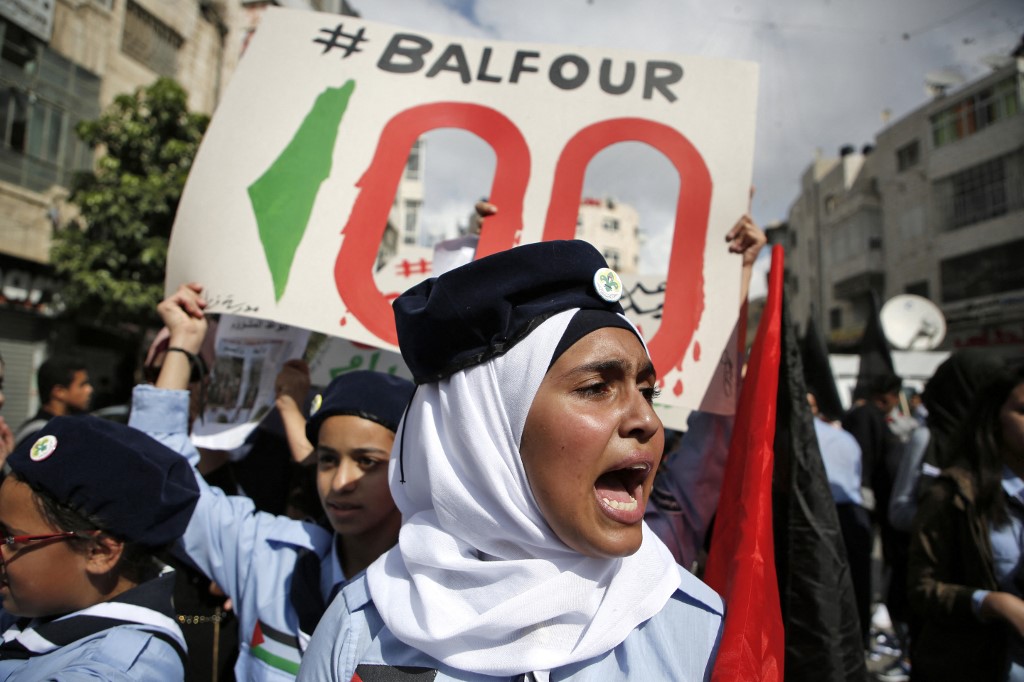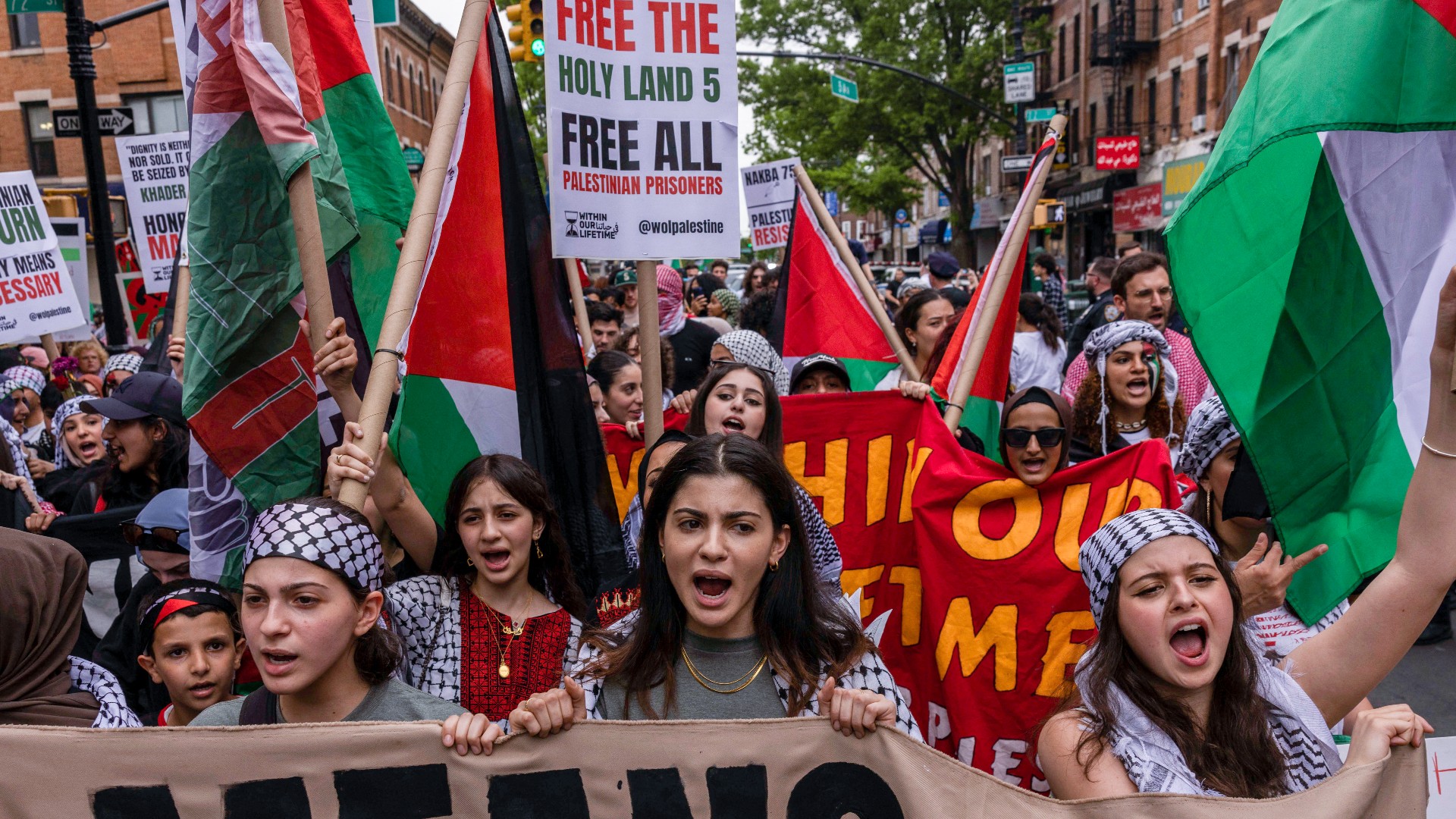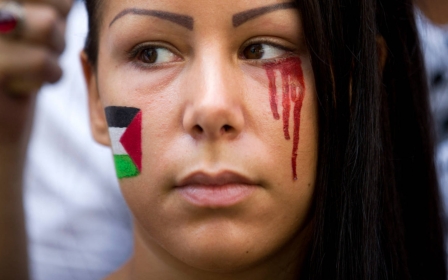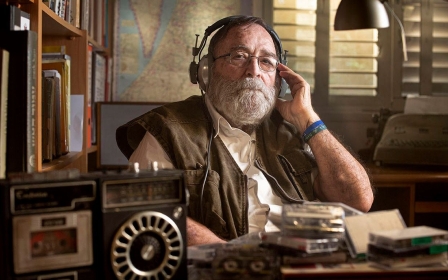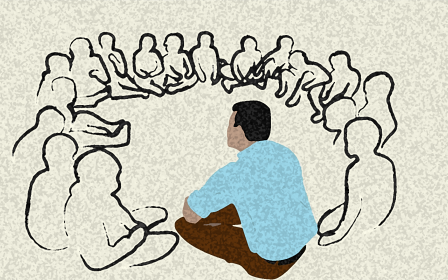Nakba at 75: Palestinian citizens of Israel are exiles in their own land

On 26 April, thousands of 1948 Palestinians participated in the annual al-Awda (return) march, which took place in the depopulated village of Lajjun.
It is the 26th march organised by the Association for the Defence of the Rights of the Internally Displaced (Adrid) to commemorate the 75th anniversary of the Palestinian Nakba (catastrophe).
The association organises this march on the same day that Israel celebrates its independence with two main slogans: "Your Independence Day is our Nakba Day" and "We will not abandon the right of return, al-Awda."
New MEE newsletter: Jerusalem Dispatch
Sign up to get the latest insights and analysis on Israel-Palestine, alongside Turkey Unpacked and other MEE newsletters
Earlier in the day, the protesters visit dozens of their destroyed villages, including al-Birwa, al-Damun, Kuwaykat, Hittin, al-Ghabisiyya and Saffuriyya. This year, as I have done for decades, I visited my own depopulated village of al-Birwa along with hundreds of its displaced residents.
Stolen dreams
Al-Birwa is the village from which my family - my father, mother, grandfather, grandmother, and two of my brothers - was expelled along with 1,700 other residents.
Al-Birwa is located about 10 km east of Akka, on a hill about 50 metres above sea level. By 1945, its land area amounted to 13,542 dunums (one dunum is 1,000 sqm). Agriculture was the mainstay of the village's economy. Its residents, including the sons and daughters of my family, used to grow wheat, barley, corn, sesame, watermelons, cantaloupes, fruit trees and olive trees.
In the aforementioned year, the population of al-Birwa reached 1,460 people, of whom 1,330 were Muslims and 130 were Christians. The two communities lived in an atmosphere of solidarity and love. One of the well-known feats of al-Birwa is that its Muslim population contributed to the appointment of the village priest, Gibran Khoury, by signing a petition and sending a delegation on its behalf to the Christian patriarch to persuade him to appoint Gibran.
In the year of the Nakba, in 1948, the population of al-Birwa was estimated at around 1,700 inhabitants.
The Zionist Carmeli Brigade occupied the village of al-Birwa and the sites overlooking the village on 11 June 1948. On the morning of 13 June, however, more than 200 men and women from al-Birwa and other neighbouring villages gathered, including 95 armed men headed by Abu Is‘aaf from the village of Sha‘ab, and managed to defeat the Israeli forces and liberate the village.
The victory would be painfully short-lived, however. The following day, on 24 June, the Israeli army was able to occupy and control the village again. It should be noted that the village is located in an area allocated to a Palestinian state, according to the UN Partition Resolution 181.
Following its capture, Israeli forces demolished the homes in the village, as well as the mosque and church in the following years. They confiscated the exiled residents' lands, considering their property as absentee property. Only a school, the Islamic cemetery, and the Christian cemetery remained. The two cemeteries are regularly subject to desecration by Israeli settlers.
The displaced people of al-Birwa live today in the villages of Western Galilee: Jdeideh, al-Makr, Kafr Yasif, Abu Sinan, Majd al-Krum, Kabul, al-Bi'ina, Akka, and Haifa; in Jenin and Nablus in the West Bank; and in the refugee camps of Lebanon and Syria. It is the village of the late Palestinian poet Mahmoud Darwish.
In 1949, Israeli authorities established on the lands of al-Birwa the moshav (agricultural commune) of Yas'ur and, in the following year, Ahihud. The settlers exploit the lands of al-Birwa, while most of its expelled residents live near it.
My father and mother, who got married in al-Birwa and had three children there, waited nearly 60 years to return, but their dream never came true
During the first days after the occupation, my family, like many others, lived under olive trees. They later took refuge in the Druze village of Sajur in Galilee and stayed for a few months in the home of a Druze family who provided us with food and shelter.
After that, my family moved to the village of Jdeideh in western Galilee, located less than two kilometres away from al-Birwa. My family found shelter with the Christian Makhoul family who also provided us with food other than the supplies provided by UNRWA.
After more than three years, my family moved out to make space for their son who was getting married. They moved into a room in a Muslim family's house in Jdeideh. During this time, my father, Abd al-Razeq, worked a day job at a construction materials factory and moonlighted as a guard. He was able to save some money and buy a plot of land in the village.
My family moved into a hut and shack built on the property, housing my grandfather, father, mother, and older brothers. I was born in the shack (made of tin and wood), where three other siblings followed. We became a large family in a small shack and hut, as my father, who once lived a very comfortable life in al-Birwa, continued to work in the factory day and night to provide for our family.
He continued to dream of returning to his home village, just a stone's throw away from our shack. He waited and waited, but the dream of return did not come true. On the contrary, in June 1967, Israeli forces occupied the West Bank, Gaza Strip, Golan Heights, and the Sinai Peninsula.
For my father and his extended family, the hope of return became even more distant. He decided to build a small stone house and waited. Eventually, he added two more rooms to accommodate the whole family.
My father and mother, who got married in al-Birwa and had three children there, waited nearly 60 years to return, but their dream never came true. My father passed away in 2007. In the weeks and days leading up to his death, he would ask: "Did the Jews take all our land and leave us with nothing? Where is justice?"
Stolen land
After the Balfour Declaration was issued on 2 November 1917, and with the beginning of the British Mandate (occupation), the Jews in Palestine constituted less than 10 percent of the total population and owned only about 3 percent of the land. According to the Balfour Declaration and the writ of the Mandate, the British government granted the Jewish minority full political rights, while granting the Palestinian majority only religious and civil rights.
In order to establish the Jewish national homeland in Palestine, the Zionist movement intensified immigration and settlement, strengthened land acquisition campaigns, and worked to empty these lands of their original indigenous inhabitants. This was done in cooperation with the British government throughout the Mandate years.
British repression led to the displacement of about 40,000 Palestinians during the period of the 1936-1939 Great Palestinian Revolt alone, in addition to the displacement of others before and after this period.
On 29 November 1947, Resolution 181, granted the Jews 56 percent of the area of historical Palestine, even though the land area owned by the Jews, who made up a third of the population, did not exceed 6 percent; and while Arabs constituted about half the population in the proposed Jewish state, they owned about 90 percent of its land.
The majority of Palestinians opposed the partition decision, while the majority of Jews and the Zionist leadership supported it. In light of the realities at the time and the fact that Palestinian Arabs constituted about half of the population in the Jewish state proposed by the partition decision, it was not possible to establish a Jewish state in Palestine in the full sense. That is why Zionists needed to think about implementing the ideas and plans that ensured the materialisation of the Zionist project, foremost of which was the plan of ethnic cleansing or transfer.
David Ben-Gurion, who became the first prime minister of Israel, stated on 3 December 1947, that the Jewish state must have a Jewish majority of at least 80 percent for it to be a stable and viable state. Ten years earlier, Ben-Gurion had stated in a letter to his son Amos: "We have to expel Arabs and take their places." On 10 March 1948, the Zionist leadership approved "Plan D", the plan to displace the Arabs from Palestine, or ethnic cleansing.
The first phase of the plan aimed at expelling the Arab Palestinian population from Arab Palestinian cities and mixed cities. By the end of May, Zionist forces managed to displace about 400,000 Palestinians, or a third of the total Arab Palestinian population, from their homes, cities, and villages.
The outcome of the war in 1948 and the beginning of 1949 was catastrophic. Zionist military operations continued until April 1949, with the number of destroyed towns and villages totalling 675 out of 774.
Israeli forces then occupied 78 percent of Palestine at the time they declared their state. Only 99 towns remained outside the Israeli occupation. During the period between the Partition Resolution 181 of 29 November 1947, and July 1949, Israel carried out the expulsion of the Palestinians by military force and turned at least 750,000 Palestinians into refugees outside the area in which Israel was established, while tens of thousands of displaced people remained within Israel.
By 1948, Israel occupied 14 Palestinian cities, and before declaring the State of Israel, it occupied the following cities: Jaffa, Tiberias, Haifa, Bisan, Safed and West Jerusalem. In the second half of the same year, and after the declaration of Israel, it occupied the following cities: Lydda, Ramla, Nazareth, Akka, Shefa-Amr, Majdal, Ashkelon, Ashdod and Beersheba.
Four of these cities were mixed: Jerusalem, Haifa, Safed, and Tiberias, while the rest were populated by Palestinians. It should be noted that Tel Aviv was previously a suburb of Jaffa and became a separate city from it during the 1936-1939 revolt.
Refugees in Israel
After the war ended, more than 150,000 Palestinians remained inside Israel, about 25 percent of them displaced. These internally displaced people, like their fellow refugees, were expelled from their villages, cities, and homes.
Revealing the presence of refugees inside Israel would cause more embarrassment to the state because the displaced are citizens of the country
Successive Israeli governments prevented them from returning and reclaiming their property. Other Palestinians were uprooted from their towns after the end of the war as well. There are no official statistics on the number of displaced Palestinians in Israel, which is not a coincidence, as the displaced were always neglected, obscured and marginalised like the rest of the Palestinians in Israel. Also, revealing the presence of refugees inside Israel would cause more embarrassment to the Zionist state because the displaced are citizens of the country.
Estimates indicate that the number of refugees inside Israel is about 440,000 if we take into account the displaced Palestinians in cities such as Jaffa, Haifa, Lydda, Ramleh and Akka, who returned to their cities but were denied the right to reclaim their property or return to their homes, as well as the Negev Arabs who were displaced after 1948 but remained in Israel.
The majority of the displaced Palestinians live in cities or villages very close to the places from which they were expelled or displaced, and some of them live only one or a few kilometres away from their original towns as if they are waiting to return to them. Displaced people in some villages make up the majority of their populations.
Israel imposed military rule during the 1948-1966 period on more than 150,000 Palestinians in the country, including the displaced (the military rule was not imposed on Israeli Jews, however). By imposing military rule, the Israeli government sought to achieve several goals, including preventing refugees in Israel from returning to their villages and towns from which they were expelled, and to evacuate semi-deserted Palestinian villages and deport their inhabitants to other areas inside or outside Israel to provide opportunities for Jewish settlement.
In order to perpetuate the reality of expulsion and displacement, Israel resorted to the use of emergency regulations it inherited from British Mandate authorities in 1948. These regulations give the Israeli military ruler the power to declare certain areas as security zones or closed military zones, to which entry is prohibited.
These emergency regulations were used against the Arabs during and after the end of military rule, and are still being used today. They aim to evict Arabs from their villages and lands and prevent them from returning. The Israeli authorities have declared the displaced villages closed security zones, thus continuing to prevent internally displaced people from returning to their villages.
Under these military regimes, depopulated Palestinian villages were also destroyed while a large percentage of their populations remained in Israel.
Israel considers the properties and lands of displaced Palestinians as absentee property, although those displaced inside Israel are Israeli citizens and hold Israeli identities. Therefore, the displaced populations are called "present absentees", according to the Israeli "Absentee Property Law" that was enacted in April 1950. This law defines the Palestinians who were expelled or left their towns as a result of the 1948 war as absentees.
Through this law, the state took control of the lands, apartments, banks, buildings, and all the properties that were owned by the Arab inhabitants who were expelled or fled during the 1948 war and after.
It should be noted that the Palestinians who returned through family reunification processes were still considered absentees by Israeli authorities according to the Absentee Property Law, meaning that the status of "absentee" does not disappear even if the refugee returns to the country. In other words, the person who returns and becomes a citizen of his country remains absent according to the aforementioned Israeli law.
In 1953, the custodian of absentee property transferred the Palestinian absentee property to the Development Authority which, in turn, transferred large areas of the lands of the displaced and refugees to the Jewish National Fund.
Since 1948, Israel has enacted dozens of laws that transformed the Palestinian Arab lands into state property, including the laws of expropriation for public purposes and the public interest, which essentially means the interest of Jews only and the establishment of Jewish settlements and towns.
The Nakba continues
The vast majority of the displaced, who today number about 440,000, live in the northern part of Palestine, in the areas of Haifa, Akka, Safed, Tiberias, and Nazareth. The majority of them are Muslim with a sizable Christian minority, and another part lives in the so-called Arab triangle and the Negev.
Palestinian Muslim, Christian, and mixed villages all experienced ethnic cleansing. Despite their limited capabilities, the native inhabitants resisted invasion and occupation though they were forced to capitulate in the hope of survival.
Israeli forces responded to Palestinian citizens petitioning the right of return to the Supreme Court by blowing up their depopulated villages
The displaced Palestinian citizens of Israel, the country that expelled them, believed that their situation was better than that of their fellow refugees in the West Bank and Gaza Strip, or the Arab countries surrounding Israel, and that their chance of returning to their villages and cities is better.
Some have petitioned the Israeli Supreme Court to enable their return to their ancestral homes. They hoped to benefit from the laws as citizens of Israel, but to no avail. They realised that the essence of the problem lies in the nature of the Zionist settler-colonialist project and the essence of Israel. They wanted the land without its Palestinian inhabitants. They wanted to seize the lands and buildings without their residents. Israeli forces committed dozens of massacres to empty the cities and villages of their Palestinian populations.
The internally displaced once believed that Israel is a democratic state and a state based on law. Accordingly, some Palestinian citizens of Israel that are displaced from al-Ghabisiyya, Iqrit and Kafr Bir'im, headed to the Israeli Supreme Court, but the Israeli authorities and military forces did not respect the few court decisions that tried to provide justice to these displaced persons and allow them to return.
The Israeli response came by blowing up these villages and demolishing their homes. This is what the Israeli forces did in the villages of al-Ghabisiyya, Kafr Bir‘im and Iqrit. The Israeli forces destroyed the village of Iqrit and blew up its homes on Christmas Day 1953, several months after a decision was issued by the Supreme Court to allow the expelled residents of the village to return to their homes.
The military ruler in the region issued an order to close the area, according to Regulation 125 of the discriminatory emergency laws, which prohibits expelled residents from entering hundreds of evicted villages - even today.
In the aftermath of the Madrid Peace Conference of 1991, and before the conclusion of the Oslo Accords, several displaced Palestinians formed the Initiative Committee to defend the rights of the internally displaced.
In 1995, during a public conference attended by hundreds of displaced persons, the "National Committee for the Defence of the Rights of the Displaced" was formed, in the presence of representatives from more than 30 evicted villages and towns. In the year 2000, this committee was registered as an association with the Registrar of Societies under its present name.
Since 1998, Adrid has been organising the annual march of return (to depopulated villages or towns) against Israel's Independence Day. Thousands - and sometimes tens of thousands - of Palestinians participate in these annual marches to commemorate the Nakba of the Palestinian people and affirm their right to return and restore their property.
This march has become one of the largest and most important annual events for 1948 Palestinians. So far, Adrid has organised 26 annual marches, the last of which was towards the village of Lajjun.
The participants in these marches demand the exercise of UN General Assembly Resolution 194, which stipulates the right of all refugees and displaced people to return, and the implementation of international resolutions and the Universal Declaration of Human Rights of 1948, which stipulates the empowerment of the displaced to return and reclaim their property.
The views expressed in this article belong to the author and do not necessarily reflect the editorial policy of Middle East Eye.
Middle East Eye delivers independent and unrivalled coverage and analysis of the Middle East, North Africa and beyond. To learn more about republishing this content and the associated fees, please fill out this form. More about MEE can be found here.





